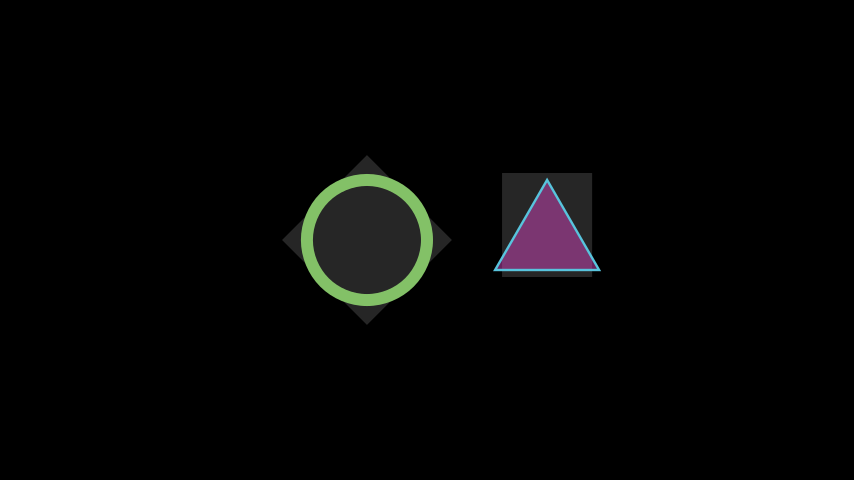BackgroundRectangle#
Qualified name: manim.mobject.geometry.shape\_matchers.BackgroundRectangle
- class BackgroundRectangle(mobject, color=None, stroke_width=0, stroke_opacity=0, fill_opacity=0.75, buff=0, **kwargs)[source]#
Bases:
SurroundingRectangleA background rectangle. Its default color is the background color of the scene.
Examples
Example: ExampleBackgroundRectangle ¶

from manim import * class ExampleBackgroundRectangle(Scene): def construct(self): circle = Circle().shift(LEFT) circle.set_stroke(color=GREEN, width=20) triangle = Triangle().shift(2 * RIGHT) triangle.set_fill(PINK, opacity=0.5) backgroundRectangle1 = BackgroundRectangle(circle, color=WHITE, fill_opacity=0.15) backgroundRectangle2 = BackgroundRectangle(triangle, color=WHITE, fill_opacity=0.15) self.add(backgroundRectangle1) self.add(backgroundRectangle2) self.add(circle) self.add(triangle) self.play(Rotate(backgroundRectangle1, PI / 4)) self.play(Rotate(backgroundRectangle2, PI / 2))
class ExampleBackgroundRectangle(Scene): def construct(self): circle = Circle().shift(LEFT) circle.set_stroke(color=GREEN, width=20) triangle = Triangle().shift(2 * RIGHT) triangle.set_fill(PINK, opacity=0.5) backgroundRectangle1 = BackgroundRectangle(circle, color=WHITE, fill_opacity=0.15) backgroundRectangle2 = BackgroundRectangle(triangle, color=WHITE, fill_opacity=0.15) self.add(backgroundRectangle1) self.add(backgroundRectangle2) self.add(circle) self.add(triangle) self.play(Rotate(backgroundRectangle1, PI / 4)) self.play(Rotate(backgroundRectangle2, PI / 2))Methods
If there are multiple colors (for gradient) this returns the first one
Given two bounds a and b, transforms the points of the self vmobject into the points of the vmobject passed as parameter with respect to the bounds.
set_styleAttributes
animateUsed to animate the application of any method of
self.animation_overridescolordepthThe depth of the mobject.
fill_colorIf there are multiple colors (for gradient) this returns the first one
heightThe height of the mobject.
n_points_per_curvesheen_factorstroke_colorwidthThe width of the mobject.
- Parameters:
mobject (Mobject) –
color (ParsableManimColor | None) –
stroke_width (float) –
stroke_opacity (float) –
fill_opacity (float) –
buff (float) –
- _original__init__(mobject, color=None, stroke_width=0, stroke_opacity=0, fill_opacity=0.75, buff=0, **kwargs)#
Initialize self. See help(type(self)) for accurate signature.
- Parameters:
mobject (Mobject) –
color (Optional[Union[ManimColor, int, str, Tuple[int, int, int], Tuple[float, float, float], Tuple[int, int, int, int], Tuple[float, float, float, float], ndarray[Any, dtype[int64]], ndarray[Any, dtype[float64]]]]) –
stroke_width (float) –
stroke_opacity (float) –
fill_opacity (float) –
buff (float) –
- get_fill_color()[source]#
If there are multiple colors (for gradient) this returns the first one
- Return type:
- pointwise_become_partial(mobject, a, b)[source]#
Given two bounds a and b, transforms the points of the self vmobject into the points of the vmobject passed as parameter with respect to the bounds. Points here stand for control points of the bezier curves (anchors and handles)
- Parameters:
vmobject – The vmobject that will serve as a model.
a (Any) – upper-bound.
b (float) – lower-bound
mobject (Mobject) –
- Returns:
self- Return type:
VMobject